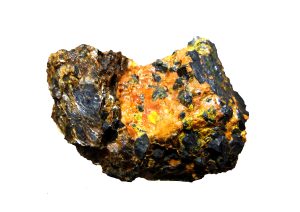What is uranium?
 Uranium is a naturally occurring, radioactive metal, primarily found in certain types of rocks. Uranium is released into the environment through erosion of these rocks, allowing uranium to be picked up by groundwater. Uranium is also released into the environment from various activities such as mining and burning coal and other fuels. Uranium breaks down (decays) very slowly into radium and radon gas.
Uranium is a naturally occurring, radioactive metal, primarily found in certain types of rocks. Uranium is released into the environment through erosion of these rocks, allowing uranium to be picked up by groundwater. Uranium is also released into the environment from various activities such as mining and burning coal and other fuels. Uranium breaks down (decays) very slowly into radium and radon gas.
How might I be exposed to uranium?
Most exposure to natural uranium is from food and water, and to a certain extent from air. People ingest about 1–2 micrograms (one microgram is one millionth of a gram) of natural uranium every day through food, and take in about 1.5 micrograms for every liter of water they drink. Uranium is found at very low levels in beef, poultry, eggs, fish, shellfish, and milk. Root vegetables, such as beets and potatoes, tend to have more uranium than other foods. These small amounts of uranium are not harmful. People who live near uranium mining, processing, or manufacturing facilities may be exposed to higher levels of uranium than most people.
In Virginia uranium is found in some bedrock, and can be dissolved in groundwater. Municipal water supply treatment removes most uranium, but it may be found in private well water.
How does uranium get into and leave the body?
Uranium can enter the body when it is inhaled or ingested. Ninety-nine percent (99%) of the uranium leaves the body in the feces. A very small portion gets into the blood and leaves through urine within a few days. A tiny fraction stays in bones for many years.
How can uranium affect my health?
Because natural uranium produces very little radioactivity, potential health effects from exposure are due to the chemical properties of uranium.
Based on experimental animal studies, the most likely adverse health effect on humans from ingesting large amounts of uranium is kidney damage. Studies of humans exposed to abnormally high levels of uranium in drinking water (averaging 100-600 micrograms per liter) for many years suggest that there may be minor damage to kidney tissue. The effects are a very mild decrease in the kidney’s ability to hold onto proteins, sugar, and other compounds. However, this damage does not cause major effects on kidney function and is reversible after the exposure to uranium stops. There are no specific symptoms after long-term consumption of drinking water containing high levels of uranium. Studies of workers with occupational exposure to uranium have not shown any evidence of serious kidney disease or other health effects.
How can uranium affect the health of children?
There is no conclusive evidence that uranium causes birth defects. Children are exposed to uranium in the same ways that adults are exposed. It is possible that if children are exposed to very high amounts of uranium, they might have some effects on their kidneys like that seen in adults. These effects are most likely reversible after the exposure to uranium stops.
How likely is uranium to cause cancer?
Humans and animals exposed to high levels of uranium for long periods of time have not shown higher than expected cancer rates. Some studies have reported lung and other cancers in uranium miners. However, the miners also smoked and were exposed to other substances that cause cancer, such as radon, silica dust, and organic solvents. Based on theoretical models, the U.S. Environmental Protection Agency (EPA) has estimated that uranium in drinking water at the current standard of 30 micrograms per liter may increase the lifetime cancer risk by less than one additional case of cancer in a population of ten thousand.
Is there a medical test to determine if I have been exposed to uranium?
In most cases, unless a person works with uranium regularly testing for uranium exposure is unnecessary. Urine analysis for uranium is the best test to determine whether you have been exposed to large amounts of uranium. There is no treatment that safely removes uranium from the body, instead the levels of uranium in the urine decrease gradually after exposure has stopped.
Urine can be tested for evidence of kidney damage, but this test cannot distinguish if the damage was caused by uranium. There are many common diseases that cause kidney damage, such as diabetes.
What is the drinking water standard for uranium?
EPA sets the standards for public drinking water. These standards or limits are known as Maximum Contaminant Levels or MCLs. The MCL for uranium in public drinking water is 30 micrograms per liter. Consuming water with levels of uranium consistently above the MCL over a long period of time (many years) may increase the risk of adverse health effects.
Some people with private wells drilled in uranium-rich rock can have high levels of uranium in their water. If you have a private well and live in an area with high uranium levels in the rock or known to have high radon levels in homes, you should test your water for uranium. If levels are too high you can install a treatment system to remove it if it is too high. See the Virginia Department of Health Office of Environmental Health Services for information on testing your private well.
If you find that levels of uranium or radium in your well water are high, you should consider testing your home for radon, a colorless, odorless gas that is emitted from uranium-rich bedrock and can contribute to lung cancer.
Where can I go to get more information on uranium?
- ATSDR ToxFAQs for Uranium
- EPA Natural Radionuclides in Private Wells
- EPA Radionuclide Basics: Uranium
Updated 2023
